Grackles and crows are a common sight across North America. They are quite similar in their overall black appearance and behavior, so it might be difficult to distinguish between the two at first, but they are not as similar as you might think.
For one, crows are corvids (Corvidae family) and grackles belong to the blackbird family (Icteridae). Their main differences reside in their shape and size, appearance, flight, and vocalization.
On this page
Body & Shape
Grackles and crows are both medium-sized birds with black, slightly glossy plumage.
The first and easiest way to compare the two is by their body shape. Grackles look more stretched and slender with a tail that is quite long in relation to their body size, whereas crows are bulkier and have shorter tails.
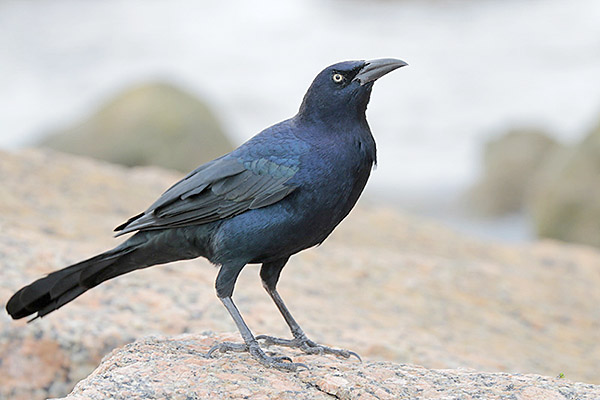
Grackles often have long and slim bodies, accentuated by their long tails. Photograph © Greg Lavaty.
They both have black legs and a black bill, so in terms of color, the easiest way to differentiate between the two would be the iridescence of their plumage and the color of their eyes.
Adult grackles’ feathers are black with purple, green, or blue sheen on the head and bronze on the rest of the body, which can be best seen in the sunlight. Their eyes are yellow or have a golden hue.
Depending on the sex and age of the bird, slight variations exist, such as adult females are usually less shiny and mostly brown, their tails are shorter and they are smaller.
Juvenile birds are brown, don’t shimmer and their eyes are also brown.
Related: Blackbird vs Crow vs Raven
Adult crows, on the other hand, are all black, including their eyes, although you might meet a juvenile crow with blue eyes.
Their plumage is mildly glossy, which is especially noticeable in the sunlight, but it doesn’t even come close to the colors that grackles display. There are little to no differences between the sexes.
Size
If you happen to see the birds at the same time, then identifying them becomes much easier.
Although both are medium-sized, then crows are slightly larger. While crows measure between 16 to 20 inches from beak to tail with a wingspan of 33 to 39 inches, then grackles are only 11 to 13 inches long with a wingspan of 14 to 18 inches.
Crows (11-21 oz) also weigh around four times more than grackles (2.5-5 oz).
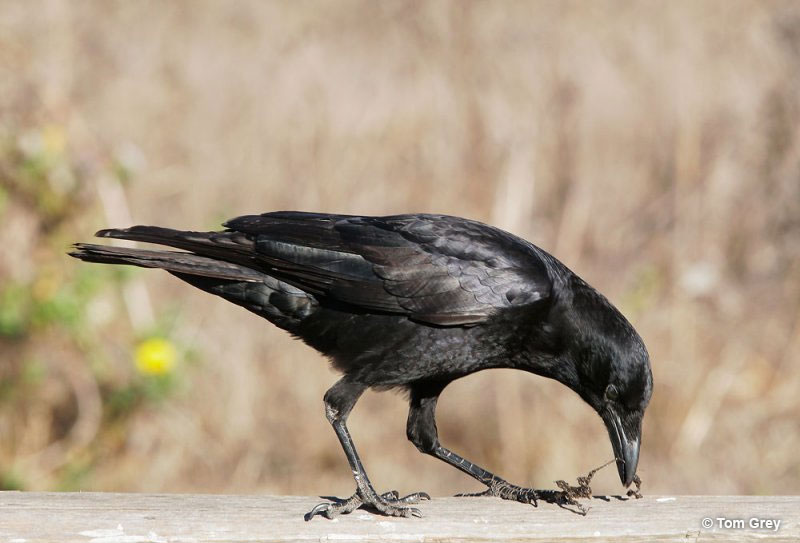
Crows are often bigger in size, compared to grackles. © Tom Grey
Flight
Observing the birds fly can also give you hints at which one of them you’re looking at. If you’re not good at estimating wingspan, then you can look out for other identifying factors such as the shape of the wing and how they fly.
Crows have fairly broad and rounded wings with wingtip feathers spreading out like fingers. They have a short tail that is rounded or squared off at the end and they fly with a rowing motion, sometimes incorporating glides.
You can often see grackles flying in big flocks. They usually fly straight on stiff wingbeats, not using those rowing motions you can see crows doing. Their tail is in a V-shape and is long relative to their body size.
Age
Grackles can live up to 22 years in the wild, but they have an average lifespan of 17 years. Crows, however, have an average life expectancy of 7-8 years, but they have been known to live up to 30 years.
Behavior
What clearly separates the two species is their typical song. Grackles’ song lasts barely a second and is described as sounding like a rusty gate: a guttural squeak, accompanied by high-pitched and clear whistles.
A crow’s call is loud, short, rapid, and harsh caw-caw-caw, during which the bird thrusts its head up and down. Both birds can mimic the sounds of other birds, sometimes even humans, but they’re not as good as mockingbirds.
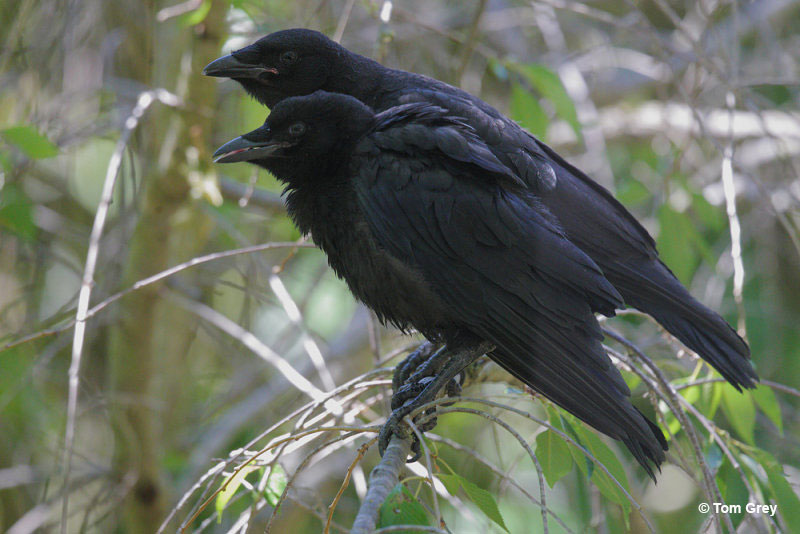
Crows and grackles are both social, intelligent, resourceful, and adaptable, although it varies across specific species. Grackles are noisy, lively birds often forming large and loose colonies of up to 200 pairs, which can also contain other bird species.
They’re not territorial, except when it comes to protecting their nest. However, despite their social nature, they sometimes attack other birds, including their own species by scratching, clawing, or diving at them. Crows are more solitary, although they too form groups.
Grackles and crows both prefer to form groups and flocks to better defend and raise their offspring, although there are differences.
Related: What is a group of crows called?
Grackles are serially monogamous, that is, they form pairs that last one breeding season. At the beginning of the breeding season, you can observe three kinds of playful chases: a group of males will follow a slow-flying female; a single male will chase a female at high speed; male and female will fly slowly alongside each other.
Crows mate for life and the mated pairs form larger units, where every bird helps raise the young.
Intelligence
Although both species are intelligent and resourceful, then crows take it to another level. For one, crows hold funerals and try to figure out who or what killed someone from their group. They work together to harass or drive off predators, devise solutions to problems, use and modify tools to solve problems, and recognize new and unusual sources of food.
This resourcefulness, sociability, and willingness to adapt to areas inhabited by humans is oftentimes seen as annoying and troublesome, earning themselves the title ‘pests’.
Large flocks of birds from either species gather around specific areas where they can find food and shelter (such as dumpsters, landfills, and roosting sites) and can start harassing passersby.
Both of them can be found almost anywhere and they do well in manmade landscapes, especially places that offer trees to perch on, such as farmlands, city parks, cemeteries, yards, shores, rivers, marshes, etc., but they avoid large unbroken areas of forest and deserts.
Diet
Grackles and crows are both omnivorous. Grackles prefer to forage seeds, berries, and grain, catch insects, minnows, and frogs, eat eggs and sometimes even hunt small birds and mice.
They might even attack other birds and snatch their food from under their beaks. Crows also eat different seeds, nuts, fruits, frogs, eggs, and grains. They are active hunters who prey on mice, young rabbits, and other small animals and scavenge carcasses.
Related: What do crows like to eat?
Both of them may visit bird feeders. Crows often search around dumpsters and don’t say no to human food and scraps.
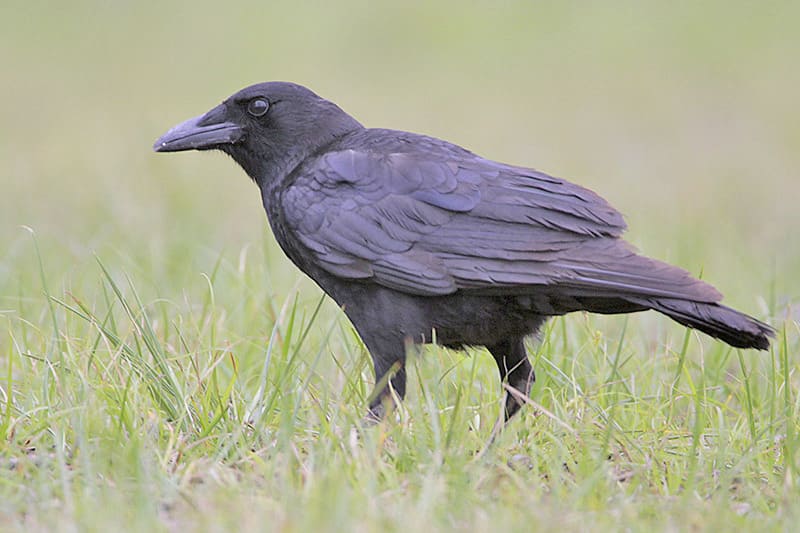
Photograph © Greg Lavaty
Location
They are common across all of North America, with the crows being a bit more widespread. Grackles can be found east of the Rocky Mountains, while crows are spread all over North America.
Grackles are more migratory, flying a little south during the winter, although some of them choose to stay and brave the cold.
Crows are partially migratory. Some populations migrate as needed, and some stay put.
Nest
Both grackles and crows prefer to build their nest in places that hide them. Grackles prefer to nest in well-concealed areas, such as dense trees or shrubs, that are close to open areas and water, sometimes in cavities or man-made structures.
Crows typically build their nest on a branch near the trunk towards the top of the tree. Similar to grackles, they prefer to nest in evergreens.
Grackle’s nest is typically high in a tree between two vertical branches or on a horizontal one, they’re rarely in a birdhouse, woodpecker holes, or barns.
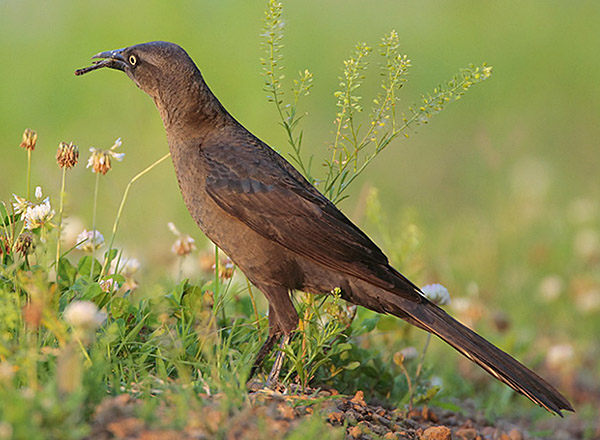
Female grackles build the nest, while the male occasionally helps. Photograph © Greg Lavaty.
Female grackles choose the nesting grounds and build the bulky cup from twigs, leaves, grass, bits of paper, string, and cloth, and reinforce it with mud, lining it with fine grass and hair. The male will follow around, sometimes helping with building and repairs.
The nest takes from one to six weeks to finish and will be 6-9 inches wide, 3-4 inches inside, and 3-9 inches deep.
Crows build their nest from medium-sized twigs and bolster the inside with weeds, soft bark, and animal hair. Both sexes, and sometimes even the breeding pair’s previous offspring, build the nest together and it can be significantly larger than a grackle’s nest, typically being 6-19 inches across, 6-14 inches wide inside, and 4-15 inches deep.
If you are unsure about whose nest it is, then the size of it and the twigs used is usually a great tell.
Eggs
The eggs are similar in color and size. Grackle eggs are 1-1.3 inches in length and 0.8-0.9 inches in width. Crow’s eggs are slightly larger: 1.4-1.9 inches in length and 1-1.2 inches in width.
There are usually 4-7, sometimes more, sometimes fewer eggs in a grackle’s nest and they can be light blue, pearl gray, white, and dark brown, usually with brown blotches. Crow’s eggs are bluish-green to olive green with brown blotches and there are 3-9 eggs in a clutch.
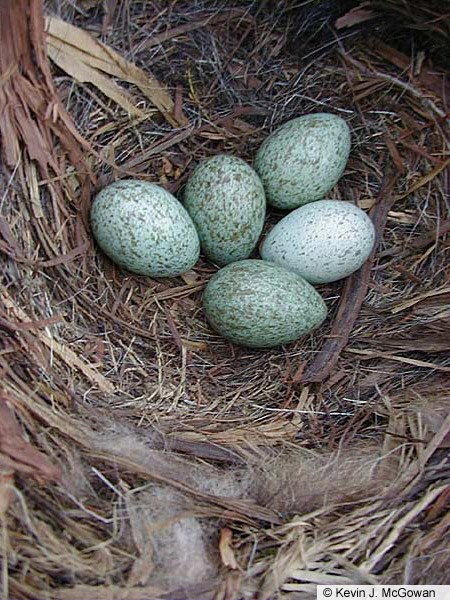
American crow nest and eggs
Both species can have 1-2 broods during one breeding season. The female grackle will incubate the eggs for 12-14 days. The male may forsake its mate to breed with another female but can also return to feed the hatched younglings.
As for crows, the female mostly incubates alone for 16-18 days and the male stays nearby, feeding them. Young grackles leave the nest in about 12-16 days after hatching, whereas young crows leave the nest about 4-5 weeks after hatching.
Frequently Asked Questions
How can you tell a crow from a grackle?
Crows are bigger, bulkier, and black from beak to toe. Grackles usually appear all black but they have a purple, green, or bronze iridescent coloring to their feathers that are especially visible in sunlight.
Grackles also have yellow eyes, whereas a crow’s eyes are black. They also appear different in flight. Crows fly making rowing motions, Grackles fly on stiff wingbeats. Grackle’s tail is in a V-shape whereas a crow’s is rounded or squared off at the end.
Their song is one of the most differentiating factors. Grackle’s song lasts just under a second and sounds like a rusty gate, a squeak with clear whistles. Crow’s call is a harsh, loud, and rapid caw-caw-caw.
Are grackles as smart as crows?
Grackles are quite smart, especially when it comes to foraging, but they are not considered as smart as crows. Crows display extraordinary intelligence when it comes to solving problems, remembering faces, and discovering new and unusual food sources.
Are grackles related to ravens or crows?
Grackles are related to neither ravens nor crows. Grackles belong to the blackbird family, also known as the Icterids, whereas crows and ravens belong to the corvids, also known as the Corvidae family.
Are grackles in the crow family?
Grackles belong to the blackbird family (Icterids), whereas crows belong to the corvids (Corvidae family).
Why do grackles chase crows?
Grackles chase crows to drive them away from their nests and breeding grounds. Crows are larger than grackles and, therefore, potential predators since crows can and will eat their eggs and young hatchlings.
Conclusions
Grackles and crows do not belong to the same family but can appear quite similar at first glance. If you look a bit closer, then there are many differences.
Crows are bulkier and all black, whereas grackles are slenderer; they have more color to their feathers in the sunlight and their eyes are yellow.
They fly differently – crows use rowing motions, whereas grackles’ flight appears stiff. A grackle’s tail is V-shaped, whereas a crow’s is either rounded or squared off at the end.
Crows make harsh, rapid, and loud caw sounds, whereas a grackle’s song is a short squeak with whistles similar to what an opening rusty gate sounds like.
Despite those differences, you can find both of them in the same habitats and environments, and their nests and eggs are also quite similar. They are both social, intelligent, and resourceful birds.

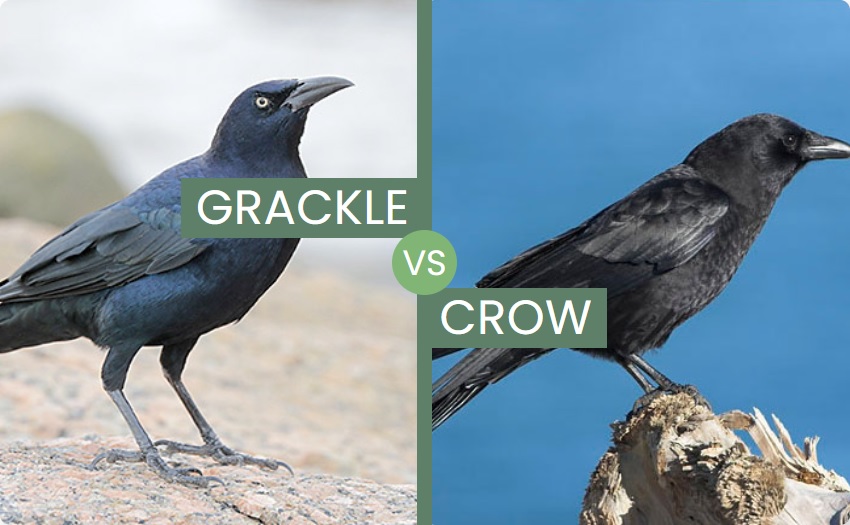
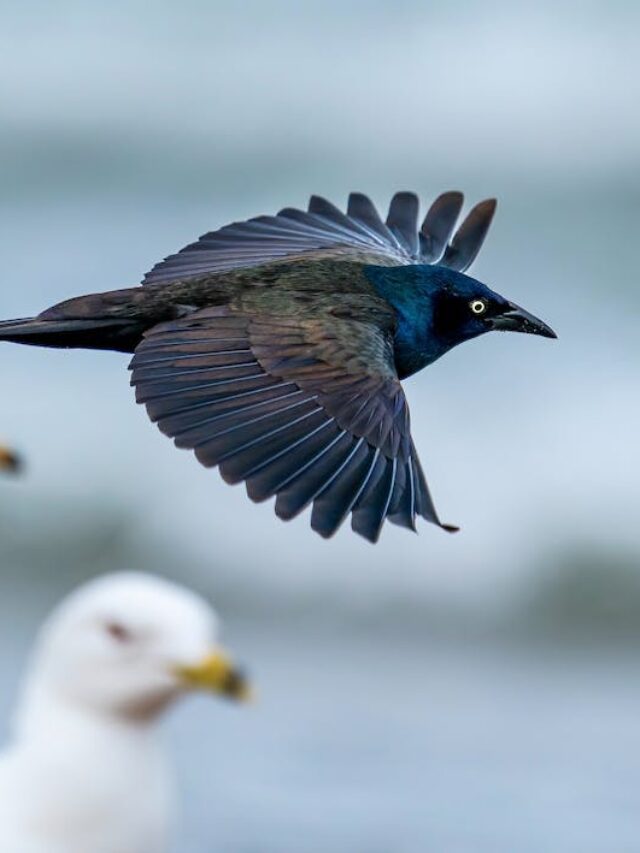
Joanna Pearlman
Monday 15th of April 2024
Crows come to my apt balcony daily to eat dry cat food I leave for them. I see some with deformed beaks, long & thin. Is this common? Also, one Crow has shown up who has a head twice the size of other crows & more sqare shaped. It can eat & fly ok. Is it another type of Crow? Only one I've seen with head like that.
Patrick O'Donnell
Tuesday 16th of April 2024
@Joanna- Beak deformities in crows and other birds do happen. It's not super common but we do see that from time to time. As for the bird with the larger head, that could be another species. It would be great if you could get a picture of it!